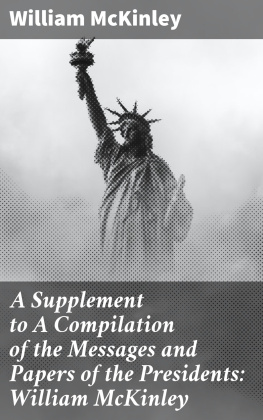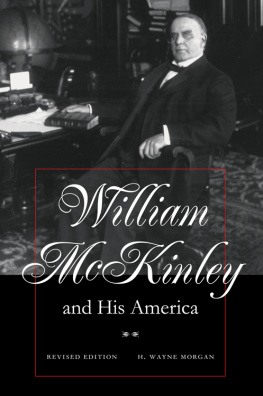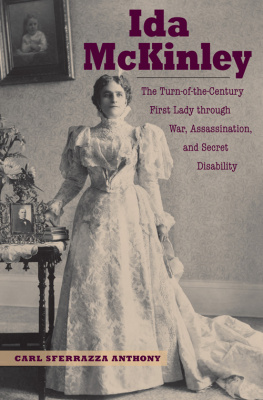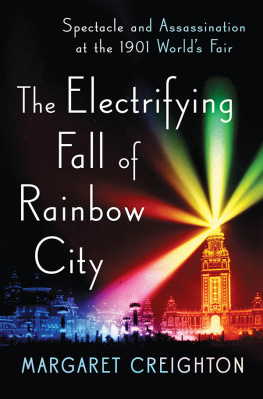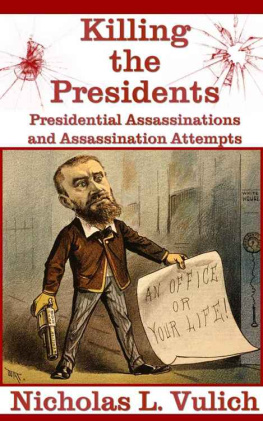
McKinley, Murder and the Pan-American Exposition
A History of the Presidential Assassination, September 6, 1901
Roger Pickenpaugh

McFarland & Company, Inc., Publishers
Jefferson, North Carolina
LIBRARY OF CONGRESS CATALOGUING DATA ARE AVAILABLE
BRITISH LIBRARY CATALOGUING DATA ARE AVAILABLE
e-ISBN: 978-1-4766-2591-1
2016 Roger Pickenpaugh. All rights reserved
No part of this book may be reproduced or transmitted in any form or by any means, electronic or mechanical, including photocopying or recording, or by any information storage and retrieval system, without permission in writing from the publisher.
Front cover: William McKinley delivering his last address, Buffalo, New York, September 5, 1901 (Library of Congress)
McFarland & Company, Inc., Publishers
Box 611, Jefferson, North Carolina 28640
www.mcfarlandpub.com
To Jill
Acknowledgments
A project of this sort produces a number of debts. As with so many other projects, my greatest debt is to my wife, Marion. She accompanied me on a number of research trips, served as a skilled proofreader, and once again assumed the tedious task of preparing the index. Her only request was a simple one. After our first visit to Buffalo, in May, and encountering snow flurries, she informed me that my next book had better be set in the Virgin Islands.
My mother, Fern Pickenpaugh, again served as a proofreader and supporter.
Having two stepdaughters and sons-in-law in northern Virginia made research trips to Washington, D.C., a blessing. Thanks again to Mike and Anya Huie and Jocelyn and Patrick Brooks, as well as grandchildren Parker Dianne and Patrick Harrison Brooks.
Locally, members of the Noble County Authors Guild acted as skilled proofreaders and much needed supporters. Thanks to Jim Leeper, Mary Lou Podlasiak, Gary Williams, and Ken Williams. Noble County, Ohio, prosecuting attorney Kelly Riddle read the entire manuscript. Her comments on the Czolgosz trial were especially helpful. Likewise, Dr. Rick Nelson of The Ohio State University Hospital offered incisive comments on medical aspects of the work. John Schockling provided numerous comments, particularly on the Expositions agricultural displays. Professor Kim Fuller of Plains, Georgia, offered a number of incisive comments, as did Dr. Evan Kutzler, a recent Ph.D. graduate from the University of South Carolina.
Librarians and archivists, of course, make any work of history possible. First and foremost for this one was Cynthia Van Ness, director of library and archives at the Buffalo History Museum. Her patience, professionalism, and courtesy were most appreciated. Thanks to her, my eight trips to Buffalo were all productive. Early on, I also appreciated the skilled assistance of Sara Lawrence, who for some reason deserted Buffalo for the Pacific coast.
I also made a number of trips to the Buffalo and Erie County Public Library. There I enjoyed the able help of Amy Pickard, Carol Pijacki, Rhonda Konig, and Franklin Clendening.
At the National Archives II in College Park, Maryland, Jason Staton helped me out with manuscript materials. Holly Reed and Carla Simms did the same in the photographic section.
Closer to home, Karl Ash and Mark G. Holland provided valuable assistance at the William McKinley Presidential Library & Museum in Canton. It is a wonderful facility, and I would urge anyone planning to visit the Pro Football Hall of Fame to work in a side trip a few blocks away.
Much of the time spent in writing this book took place in Houston. While there I enjoyed the help of Sandi Edwards, head of reference services at the Fondren Library at Rice University.
As they have so many times in the past, the staff of the Muskingum University Library made this book possible. During the research process, my main inter-library loan contact person, Zelda Patterson, retired. This made her nervous, but Zeldas successor, Connie Burke, proved to be a capable successor. Thanks also to Jamie Berilla and Nicole Robinson.
Preface
On the afternoon of September 6, 1901, President William McKinley entered the garish, multicolored Temple of Music at Buffalos Pan-American Exposition. A veteran politician, he instinctively walked straight to the spot where he was to receive the public at a long planned reception. The popular chief executive, re-elected overwhelmingly ten months earlier, was looking forward to the event. He genuinely enjoyed meeting with his constituents, and he treasured the smiles he encountered as he shook their hands.
Among those not looking forward to the reception was George Cortelyou, McKinleys personal secretary. Loyal, efficient, and protective, Cortelyou was worried about the wide-open nature of the receiving line. A number of world leaders had recently been assassinated by members of a growing anarchist movement. Twice Cortelyou had attempted to remove the reception from the presidents Buffalo schedule. Twice his boss had reinserted it.
McKinley would have been wise to have heeded his secretarys concerns. Among those waiting in line to enter the Temple was a troubled young man named Leon Czolgosz. A native of Michigan and son of immigrant parents, Czolgosz had worked at a variety of factory jobs. Over time he had become disillusioned with American capitalism and his Roman Catholic faith. A few months earlier he had attended a lecture by Emma Goldman, a prominent anarchist widely known as Red Emma. Young Leon became infatuated with both her and her beliefs, although the proportions are difficult to determine.
Czolgosz came armed with a .32-caliber revolver he had recently purchased after arriving in Buffalo. He concealed it with a handkerchief; and since the day was very hot, the presence of the handkerchief did not raise any flags among the presidents small protective detail. Indeed, an individual who appeared to be an Italian aroused more suspicion, simply because of his dark, foreign appearance.
For McKinley and Czolgosz, the paths to Buffalo were divergent. The president had enjoyed a life of opportunities, and with the help of personal ability, ambition, and hard work, he had taken advantage of them. For the immigrant Czolgosz, the opportunities had been less numerous, though not entirely non-existent. He had become deeply suspicious of the industrial America that McKinley embraced, and he had come to disdain the captains of industry who were the presidents staunchest supporters.
Buffalo and its exposition were more in step with McKinleys views. The eighth largest city in America, Buffalo had emerged as a major industrial center, a factory town whose growth was supported by the protective tariffs the president famously espoused. The fair was accurately billed as a celebration of Western Hemisphere unity and friendship. Yet at the same time it was also celebrating American industrial might, specifically the potential that electrical transmission, pioneered at nearby Niagara Falls, held for Americas manufacturing future. Over one hundred thousand low wattage bulbs outlined the Expositions gaudy structures, giving evening visitors an overwhelming view of the potential of the new power source.
It was a diverse convergence that took place at Buffalo, and it presaged many of the triumphs and tensions that would mark the American Century then dawning. In McKinley was the personification of the marriage between industrialization and conservative politics. Czolgosz represented the doubts that would emerge about that marriage, particularly as they related to the treatment of the working men and women who became cogs in the industrial machine. Waiting in the wings was Vice President Theodore Roosevelt, who would eventually lend a certain respectability to Czolgoszs skeptical views of industrial society.
Next page


